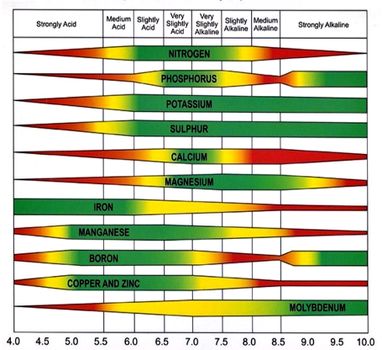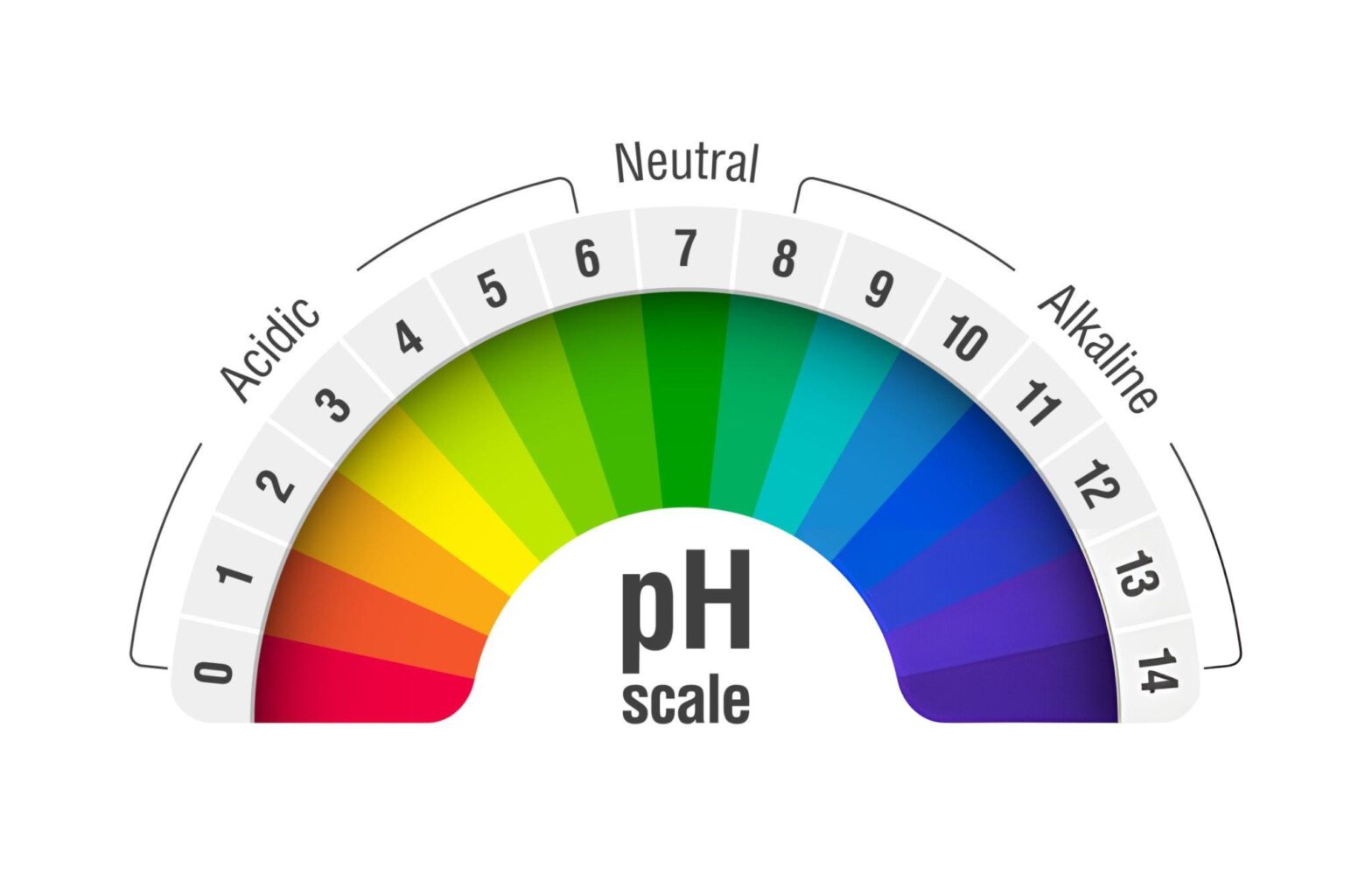What the heck is pH?
Like I started off the article with, pH stands for “potential of Hydrogen”.
It’s a measurement of a solution’s acidity or alkalinity, with a scale from 0 to 14. The measurement represents of the balance of negative hydroxide ions (OH–) to Hydrogen (H+) ions that are floating around in the solution.
Perfectly balanced solution with equal OH– and H+ ions, or none at all, will have a pH of 7.0. Acidic solutions are in the range from 0 to 6.9, the lower the number the more acidic the solution. As the ratio of H+ increases, the acidity of the solution increases.
Alkaline solutions are in the range from 7.1 to 14. The higher the number the more alkaline the solution is. As the ratio of OH– increases the more alkaline the solution becomes.
Here’s a little video from the University of Nottingham that explains potential of Hydrogen visually:
Understanding the Importance of pH Measurement
Potential of Hydrogen, or pH, balance is extremely important for plants to absorb the best balance of nutrients. Why? Well, at lower pH levels your plants absorb a bunch of some minerals, but almost none of the others, and at the other end of the scale, the might absorb a different mix of nutrients. And you’ve probably seen the chart below before:

If you look carefully at the chart, you’ll notice that you need to keep your pH under control to maximize nutrient availability to your crop.
Now, how do you do that? In hydroponics, you simply add pH down or pH up to your nutrient solution. In soil, adding nitrogen will lower pH over time, and adding liming agents will help raise it.
But you also need to measure pH to know what to do. Measuring the acidity or alkalinity of a solution, or taking pH reading, is how you get your bearings.
You can do it with a chemical test kit, which are available for hydroponic solutions and soil, or you can use a digital pH meter for much faster readings.
If you’re like me, I find the chemical tests laborious and I’d rather save my time for doing other things — so I always go for the digital pH meter. A good quality meter is nearly instantaneous and accurate. There is a lot of technology to unpack that I’ll go over in this article.

Let’s put this into context to drive home my point. Take a hydroponic system, for example, these systems are soil-less, relying wholly on nutrient solutions to feed the plants. Any imbalance in the solution’s pH could result in poor nutrient absorption by plants leading to stunted growth or even plant death. Refer back to the chart at the top of the article.
It turns out that maintaining a pH between 5.5 and 6.5 is optimal for most plant health in hydroponic systems. So your plants will benefit from monitoring and adjustments to the pH levels, and they will produce better crops.
Key Considerations When Buying a pH Meter
When it comes to purchasing your new meter, there are a some important factors to keep in mind. Chief among these is accuracy. A digital pH meter needs to provide high accuracy and reliable readings. A high-quality digital meter should measure anything from sour lemon juice with a pH of 2, up to the alkalinity of soapy water which sits around 12.
PH probe
The accuracy of the unit largely relies on its ability to detect hydrogen ions effectively. The most accurate ph meters can pick up subtle changes in hydrogen ion concentration allow for more precise measurements. The quality of the pH probe is probably the most important part. This component acts as the sensor and directly interacts with the solution being tested. Higher quality probes equipped with improved sensitivity will deliver accurate results over a wide range of pH levels.
Another important feature of the pH probe is the “double junction”. It refers to the advanced design approach that creates a better contact between the electrode and the sample. This enhances measurement accuracy. A double junction pH meter significantly reduces the chances of contamination that can skew your readings.
Calibration
Also, calibration is an essential process when using these meters and influences their readings’ integrity. Easy and fast calibration is an important feature in any ph tester. Some meters come with calibration solutions included or have automated calibration routines for user convenience. You definitely want to calibrate your meter regularly, so pick up some pH meter storage solution too.
Here’s a video on how to calibrate a HM Digital pH meter:
Waterproof Case
A hallmark of any excellent digital pH meter pen is its “waterproof” capabilities. Most equipment damage in farming results from moisture interference. A waterproof digital pH meter offers a good base-line level of protection from water damage – giving you better return on investment.
Automatic Temperature Compensation (ATC)
Temperature variations can influence pH readings, making it another critical factor to consider when choosing a high-quality pH meter. ATC automatically adjusts readings based on the sample’s temperature. This technology guarantees reliable and accurate results regardless of environmental changes – which appallingly account for about 20% of inaccurate readings according to an industry report by Technical Tools Incorporated.
LCD Display
Another key consideration when choosing a digital pH meter is the LCD display. An easily-readable display contributes significantly to the your experience. Many probes have a hold button, so you don’t have to look at the meter directly when taking readings.
You must consider your particular needs and application. Different meters are designed with specific users in mind – some are perfect for hydroponic farming, while others are tailored for industrial or laboratory use. Most users will be happiest with an affordable pen-style digital ph meter, but some would rather use a professional meter with a wired probe for testing in a laboratory like environment.
Tips for Maintaining and Calibrating Your pH Meter
Maintaining and calibrating your pH meter is as important as selecting the best pH meter to keep it functioning in an accurate and reliable manner.
Regular maintenance doesn’t only enhance the lifespan of your device — it also plays a pivotal role in ensuring accuracy in your measurements. This cannot be overemphasized — without regular calibration, even the best pH meter might give you inaccurate readings. Calibration is not only a routine maintenance process; it’s the guarantee that your pH meter will give you precise readings.
HM Digital PH80
The PH-80 by HM Digital combines affordability with reliability. For the price of a replacement probe you get an entire device.
Multi point calibration: 4, 7, and 10 available
PH range 0 – 14
One-touch automatic digital calibration
Water resistant
Automatic Temperature Calibration included with a temperature display
Proper care goes a long way in optimizing the accuracy of your pH electrode. Electrodes are not plug-and-play devices! Each time you use your pH meter, remember to rinse the electrode with distilled water to remove any impurities left from previous usage or storage solution.
Inadequate cleaning and incorrect storage can reduce electrode performance massively, and that will have far reaching implications for your nutrient solution and plant growth. So make sure you get high quality storage solution and put it in the cap before putting away your hand held and pen ph meter, every time.
Moving onto calibration, the source of your tool’s precision. The process of ph calibration involves adjusting the meter to read certain known values under specific conditions. It’s best to do what is called a two-point calibration. This means you calibrate using at least two standard buffer solutions that bracket your expected pH range. For hydroponics farmers you will commonly use pH 4.0 and pH 7.0 calibration solutions.
You might be wondering why not just one? Well, using two points allows for the calculation of both slope and offset… and you guessed it, that improves accuracy. To get the most accurate and reliable results with your ph meter, we recommend that you calibrate it at least once a week.
Eventually though, all good things come to an end. Yes, eventually all pH probes will wear out. It’s the nature of how they take measurements. They literally have a chemical reaction inside the little glass probe each time they are used. So keep in mind, depending on how often and how concentrated the solutions are, you’ll need to replace the probe, or if it is an all in one, the entire meter. It’s like the tires of your car, they get worn down little by little with each use.
